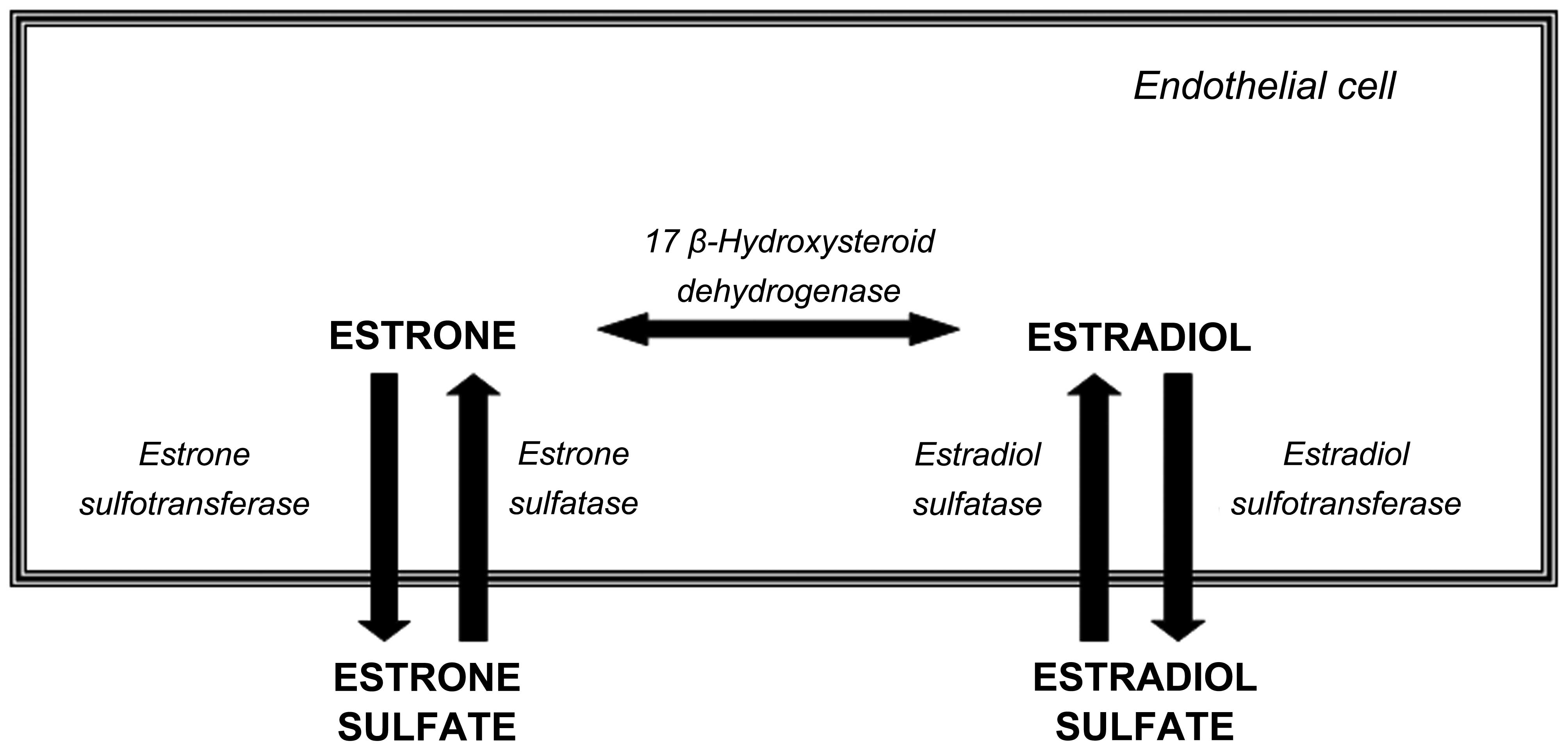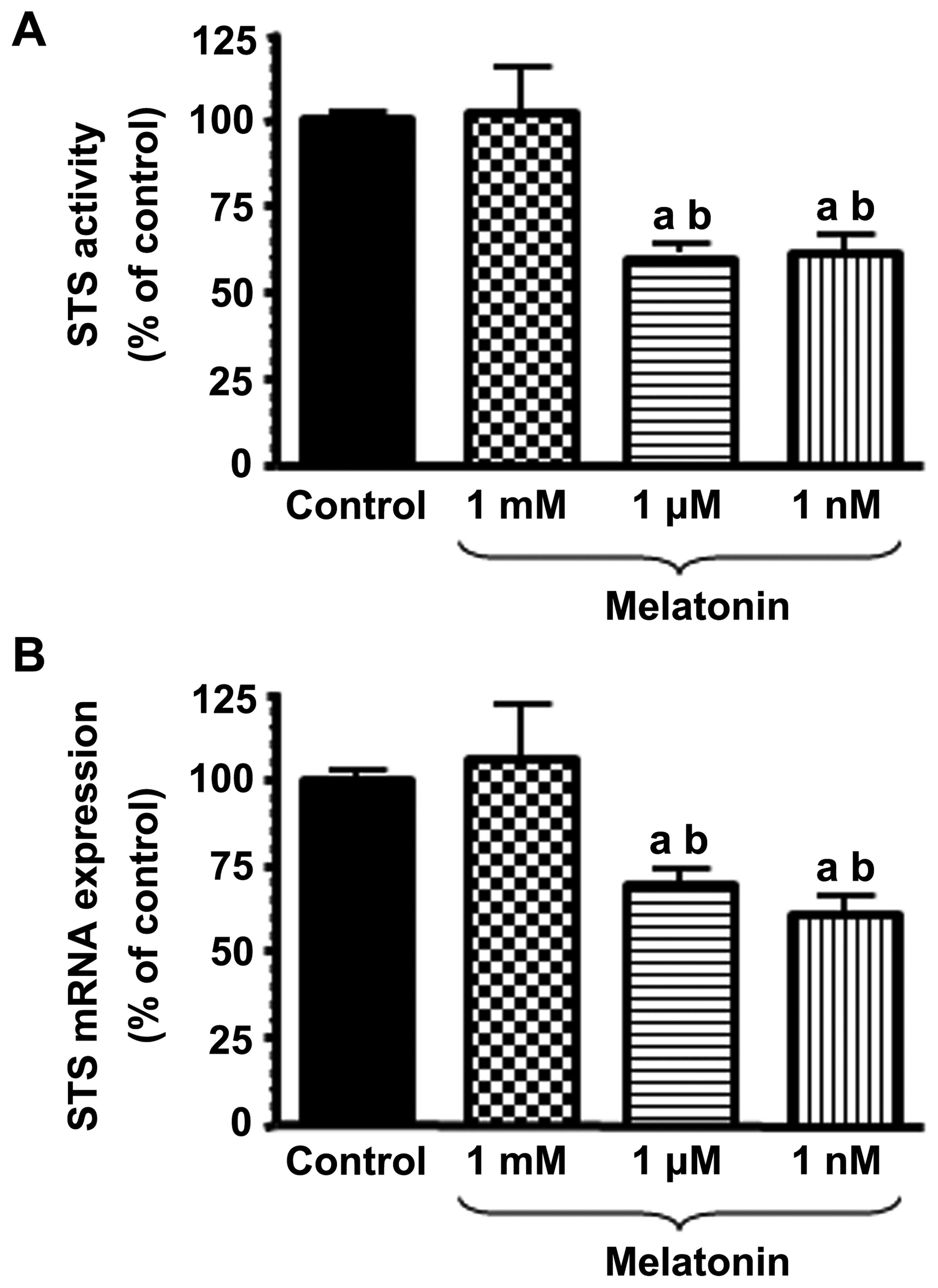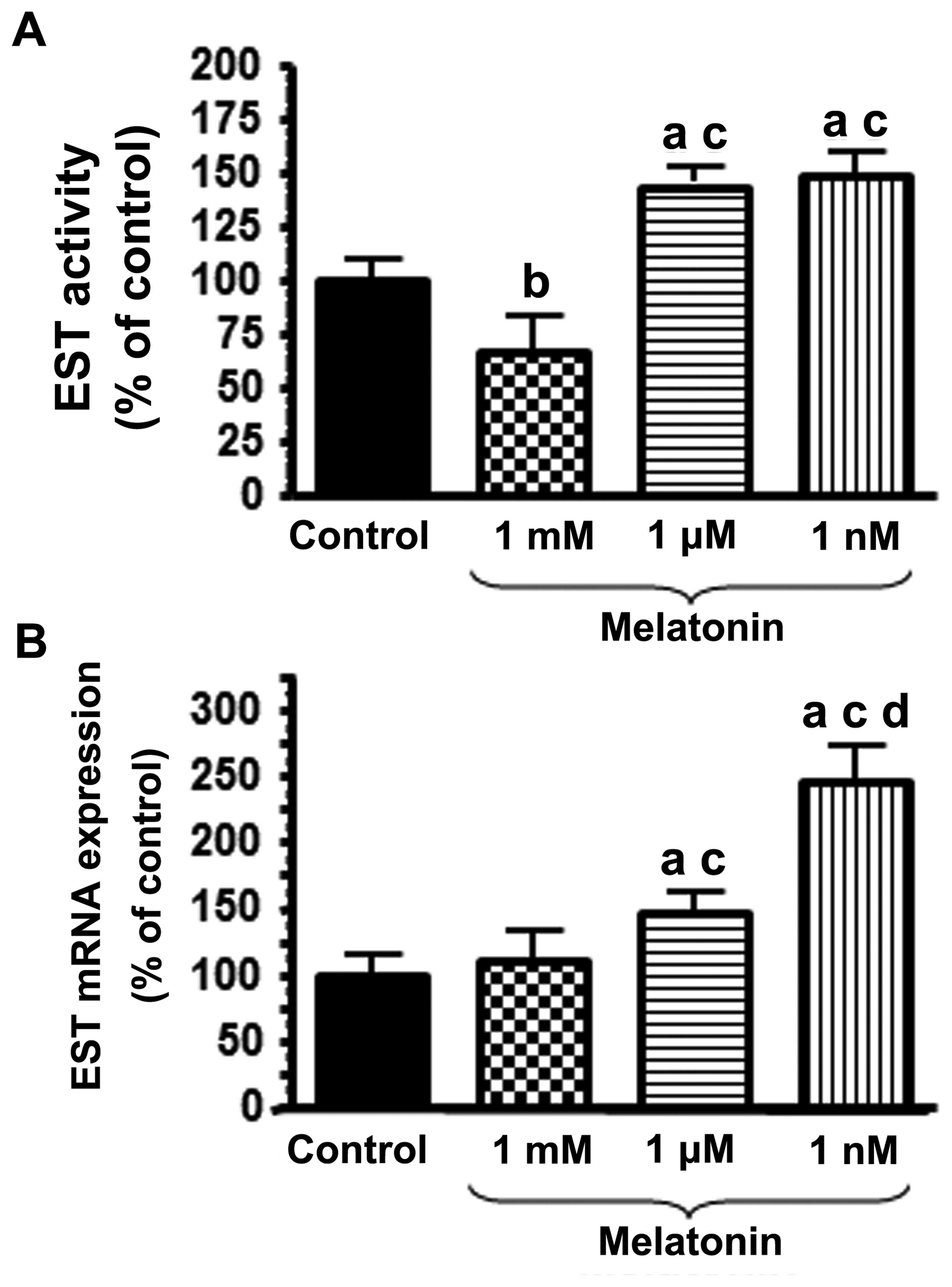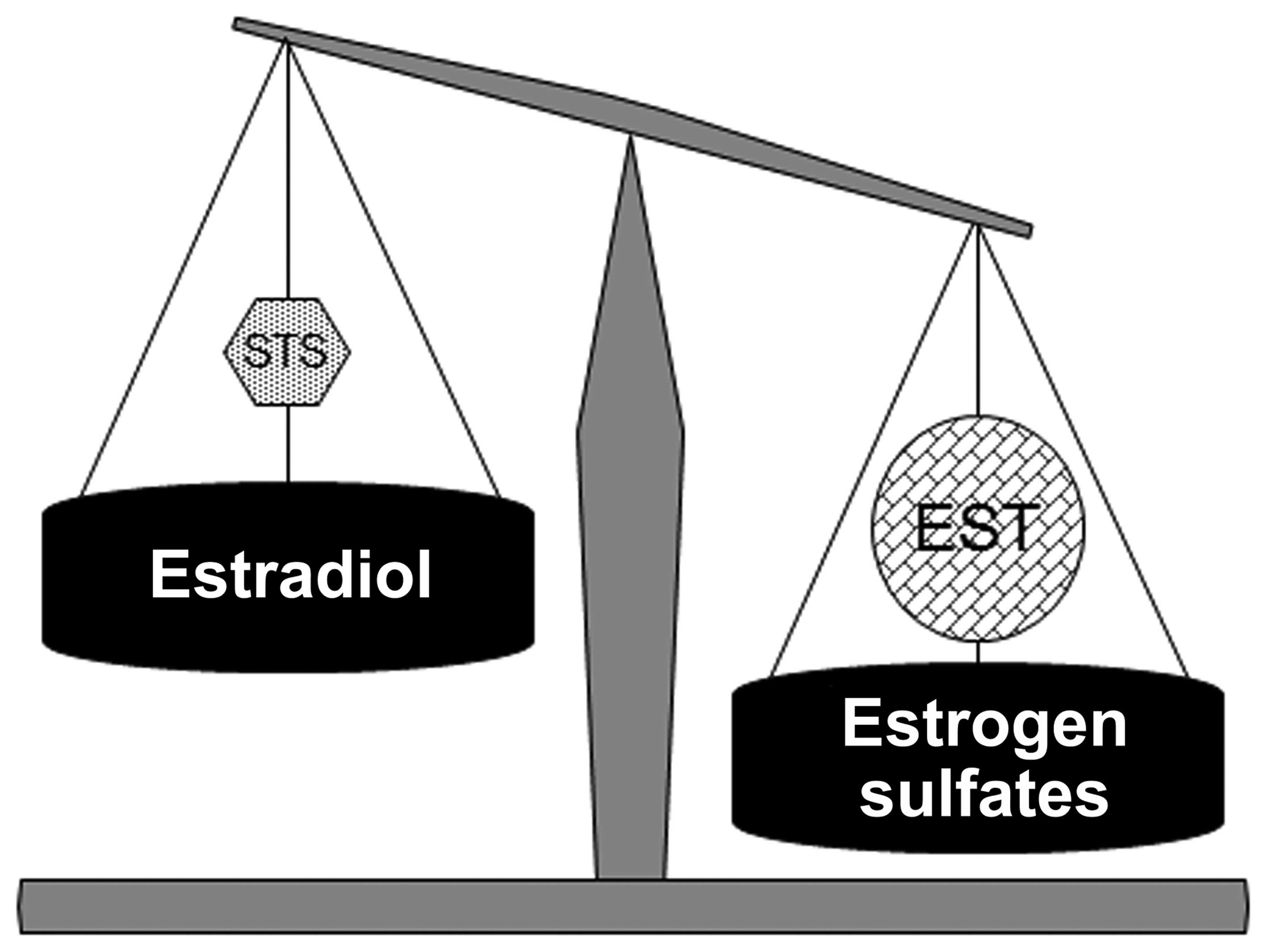|
1
|
Germain D: Estrogen carcinogenesis in
breast cancer. Endocrinol Metab Clin North Am. 40:473–484. 2011.
View Article : Google Scholar : PubMed/NCBI
|
|
2
|
Pelekanou V and Leclercq G: Recent
insights into the effect of natural and environmental estrogens on
mammary development and carcinogenesis. Int J Dev Biol. 55:869–878.
2011. View Article : Google Scholar : PubMed/NCBI
|
|
3
|
Russo J and Russo IH: The role of estrogen
in the initiation of breast cancer. J Steroid Biochem Mol Biol.
102:89–96. 2006. View Article : Google Scholar : PubMed/NCBI
|
|
4
|
Pasqualini JR and Chetrite GS: Recent
insight on the control of enzymes involved in estrogen formation
and transformation in human breast cancer. J Steroid Biochem Mol
Biol. 93:221–236. 2005. View Article : Google Scholar : PubMed/NCBI
|
|
5
|
Stanway SJ, Delavault P, Purohit A, Woo
LW, Thurieau C, Potter BV and Reed MJ: Steroid sulfatase: a new
target for the endocrine therapy of breast cancer. Oncologist.
12:370–374. 2007. View Article : Google Scholar : PubMed/NCBI
|
|
6
|
Pasqualini JR: The selective estrogen
enzyme modulators in breast cancer: a review. Biochim Biophys Acta.
1654:123–143. 2004.PubMed/NCBI
|
|
7
|
Suzuki T, Miki Y, Nakamura Y, Moriya T,
Ito K, Ohuchi N and Sasano H: Sex steroid-producing enzymes in
human breast cancer. Endocr Relat Cancer. 12:701–720. 2005.
View Article : Google Scholar : PubMed/NCBI
|
|
8
|
Suzuki T, Miki Y, Nakata T, Shiotsu Y,
Akinaga S, Inoue K, Ishida T, Kimura M, Moriya T and Sasano H:
Steroid sulfatase and estrogen sulfotransferase in normal human
tissue and breast carcinoma. J Steroid Biochem Mol Biol.
86:449–454. 2003. View Article : Google Scholar : PubMed/NCBI
|
|
9
|
Cos S, González A, Álvarez-García V,
Alonso-González C and Martínez-Campa C: Melatonin and breast
cancer: selective estrogen enzyme modulator actions. Advances in
Cancer Drug Targets. Atta-ur-Rahman: 1. Bentham Science Publishers;
Sharjah, UAE: pp. 207–237. 2013
|
|
10
|
Sasano H, Suzuki T, Nakata T and Moriya T:
New development in intracrinology of breast carcinoma. Breast
Cancer. 13:129–136. 2006. View Article : Google Scholar : PubMed/NCBI
|
|
11
|
Cos S and Sánchez-Barceló EJ: Melatonin
and mammary pathological growth. Front Neuroendocrinol. 21:133–170.
2000. View Article : Google Scholar : PubMed/NCBI
|
|
12
|
Cos S and Sánchez-Barceló EJ: Melatonin,
experimental basis for a possible application in breast cancer
prevention and treatment. Histol Histopathol. 15:637–647.
2000.PubMed/NCBI
|
|
13
|
Hill SM and Blask DE: Effects of the
pineal hormone melatonin on the proliferation and morphological
characteristics of human breast cancer cells (MCF-7) in culture.
Cancer Res. 48:6121–6126. 1988.PubMed/NCBI
|
|
14
|
Blask DE, Sauer LA and Dauchy RT:
Melatonin as a chronobiotic/anticancer agent: Cellular,
biochemical, and molecular mechanisms of action and their
implications for circadian-based cancer therapy. Curr Top Med Chem.
2:113–132. 2002. View Article : Google Scholar : PubMed/NCBI
|
|
15
|
Sánchez-Barceló EJ, Cos S, Fernández R and
Mediavilla MD: Melatonin and mammary cancer: a short review. Endocr
Relat Cancer. 10:153–159. 2003. View Article : Google Scholar : PubMed/NCBI
|
|
16
|
Cos S, González A, Martínez-Campa C,
Mediavilla MD, Alonso-González C and Sánchez-Barceló EJ:
Estrogen-signaling pathway: a link between breast cancer and
melatonin oncostatic actions. Cancer Detect Prev. 30:118–128. 2006.
View Article : Google Scholar : PubMed/NCBI
|
|
17
|
Cos S, González A, Martínez-Campa C,
Mediavilla MD, Alonso-González C and Sánchez-Barceló EJ: Melatonin
as a selective estrogen enzyme modulator. Curr Cancer Drug Targets.
8:691–702. 2008. View Article : Google Scholar : PubMed/NCBI
|
|
18
|
González A, Cos S, Martínez-Campa C,
Alonso-Gonzalez C, Sánchez-Mateos S, Mediavilla MD and
Sánchez-Barcelo EJ: Selective estrogen enzyme modulator actions of
melatonin in human breast cancer cells. J Pineal Res. 45:86–92.
2008. View Article : Google Scholar : PubMed/NCBI
|
|
19
|
Álvarez-García V, González A,
Martínez-Campa C, Alonso-González C and Cos S: Melatonin modulates
aromatase activity and expression in endothelial cells. Oncol Rep.
29:2058–2064. 2013.PubMed/NCBI
|
|
20
|
Cos S, Martínez-Campa C, González A,
Álvarez-García V, Alonso-González C, Mediavilla MD and
Sánchez-Barceló EJ: Melatonin and aromatase in breast cancer. Clin
Cancer Drug. 1:54–64. 2014. View Article : Google Scholar
|
|
21
|
Cos S, Alvarez-García V, González A,
Alonso-González C and Martínez-Campa C: Melatonin modulation of
crosstalk among malignant epithelial, endothelial and adipose cells
in breast cancer (Review). Oncol Lett. 8:487–492. 2014.PubMed/NCBI
|
|
22
|
Alvarez-García V, González A,
Alonso-González C, Martínez-Campa C and Cos S: Regulation of
vascular endo-thelial growth factor by melatonin in human breast
cancer cells. J Pineal Res. 54:373–380. 2013.
|
|
23
|
Alvarez-García V, González A,
Alonso-González C, Martínez-Campa C and Cos S: Antiangiogenic
effects of melatonin in endothelial cell cultures. Microvasc Res.
87:25–33. 2013. View Article : Google Scholar : PubMed/NCBI
|
|
24
|
Duncan L, Purohit A, Howarth NM, Potter BV
and Reed MJ: Inhibition of estrone sulfatase activity by
estrone-3-methylthio-phosphonate: A potential therapeutic agent in
breast cancer. Cancer Res. 53:298–303. 1993.PubMed/NCBI
|
|
25
|
Falany CN, Krasnykh V and Falany JL:
Bacterial expression and characterization of a cDNA for human liver
estrogen sulfotransferase. J Steroid Biochem Mol Biol. 52:529–539.
1995. View Article : Google Scholar : PubMed/NCBI
|
|
26
|
Barnabas O, Wang H and Gao XM: Role of
estrogen in angiogenesis in cardiovascular diseases. J Geriatr
Cardiol. 10:377–382. 2013.
|
|
27
|
Chakrabarti S, Morton JS and Davidge ST:
Mechanisms of estrogen effects on the endothelium: An overview. Can
J Cardiol. 30:705–712. 2014. View Article : Google Scholar
|
|
28
|
Khalil RA: Estrogen, vascular estrogen
receptor and hormone therapy in postmenopausal vascular disease.
Biochem Pharmacol. 86:1627–1642. 2013. View Article : Google Scholar : PubMed/NCBI
|
|
29
|
Bulun SE, Lin Z, Imir G, Amin S, Demura M,
Yilmaz B, Martin R, Utsunomiya H, Thung S, Gurates B, et al:
Regulation of aromatase expression in estrogen-responsive breast
and uterine disease: from bench to treatment. Pharmacol Rev.
57:359–383. 2005. View Article : Google Scholar : PubMed/NCBI
|
|
30
|
Bulun SE, Chen D, Lu M, Zhao H, Cheng Y,
Demura M, Yilmaz B, Martin R, Utsunomiya H, Thung S, et al:
Aromatase excess in cancers of breast, endometrium and ovary. J
Steroid Biochem Mol Biol. 106:81–96. 2007. View Article : Google Scholar : PubMed/NCBI
|
|
31
|
Chumsri S and Brodie A: Aromatase
inhibitors and breast cancer. Horm Mol Biol Clin Investig.
9:119–126. 2012.PubMed/NCBI
|
|
32
|
Chumsri S: Clinical utilities of aromatase
inhibitors in breast cancer. Int J Womens Health. 7:493–499. 2015.
View Article : Google Scholar : PubMed/NCBI
|
|
33
|
Shields-Botella J, Bonnet P, Duc I,
Duranti E, Meschi S, Cardinali S, Prouheze P, Chaigneau AM, Duranti
V, Gribaudo S, et al: In vitro and in vivo models for the
evaluation of new inhibitors of human steroid sulfatase, devoid of
residual estrogenic activity. J Steroid Biochem Mol Biol.
84:327–335. 2003. View Article : Google Scholar : PubMed/NCBI
|
|
34
|
Santner SJ, Ohlsson-Wilhelm B and Santen
RJ: Estrone sulfate promotes human breast cancer cell replication
and nuclear uptake of estradiol in MCF-7 cell cultures. Int J
Cancer. 54:119–124. 1993. View Article : Google Scholar : PubMed/NCBI
|
|
35
|
Hill SM, Spriggs LL, Simon MA, Muraoka H
and Blask DE: The growth inhibitory action of melatonin on human
breast cancer cells is linked to the estrogen response system.
Cancer Lett. 64:249–256. 1992. View Article : Google Scholar : PubMed/NCBI
|
|
36
|
Molis TM, Spriggs LL and Hill SM:
Modulation of estrogen receptor mRNA expression by melatonin in
MCF-7 human breast cancer cells. Mol Endocrinol. 8:1681–1690.
1994.PubMed/NCBI
|
|
37
|
Cos S, Martínez- Campa C, Mediavilla MD
and Sánchez-Barceló EJ: Melatonin modulates aromatase activity in
MCF-7 human breast cancer cells. J Pineal Res. 38:136–142. 2005.
View Article : Google Scholar : PubMed/NCBI
|
|
38
|
Cos S, González A, Güezmes A, Mediavilla
MD, Martínez-Campa C, Alonso-González C and Sánchez-Barceló EJ:
Melatonin inhibits the growth of DMBA-induced mammary tumors by
decreasing the local biosynthesis of estrogens through the
modulation of aromatase activity. Int J Cancer. 118:274–278. 2006.
View Article : Google Scholar
|
|
39
|
González A, Martínez-Campa C, Mediavilla
MD, Alonso-González C, Alvarez-García V, Sánchez-Barceló EJ and Cos
S: Inhibitory effects of melatonin on sulfatase and
17β-hydroxysteroid dehydrogenase activity and expression in glioma
cells. Oncol Rep. 23:1173–1178. 2010.
|
|
40
|
González A, Alvarez-García V,
Martínez-Campa C, Mediavilla MD, Alonso-González C, Sánchez-Barceló
EJ and Cos S: In vivo inhibition of the estrogen sulfatase enzyme
and growth of DMBA-induced mammary tumors by melatonin. Curr Cancer
Drug Targets. 10:279–286. 2010. View Article : Google Scholar : PubMed/NCBI
|
|
41
|
Santner SJ and Santen RJ: Inhibition of
estrone sulfatase and 17β-hydroxysteroid dehydrogenase by
antiestrogens. J Steroid Biochem Mol Biol. 45:383–390. 1993.
View Article : Google Scholar : PubMed/NCBI
|
|
42
|
Li Y, Xu Y, Li X, Qin Y and Hu R: Effects
of PPAR-α agonist and IGF-1 on estrogen sulfotransferase in human
vascular endo-thelial and smooth muscle cells. Mol Med Rep.
8:133–139. 2013.PubMed/NCBI
|
|
43
|
Xu Y, Yang X, Wang Z, Li M, Ning Y, Chen
S, Yin L and Li X: Estrogen sulfotransferase (SULT1E1) regulates
inflammatory response and lipid metabolism of human endothelial
cells via PPARγ. Mol Cell Endocrinol. 369:140–149. 2013. View Article : Google Scholar : PubMed/NCBI
|













